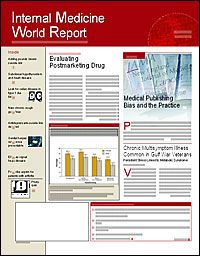Publication
Article
Internal Medicine World Report
Barrett's Esophagus More Common than You Suspect
Author(s):
New Findings Provide Clues to Who Should Be Screened
Although Barrett's esophagus (BE) is often a precursor to eso?ph-? ageal adenocarcinoma, which accounts for about 10,500 deaths in the United States annually and has the fastest growing incidence rate of all cancers, the prevalence of BE in the general population is largely unknown. A recent study published in Gastroenterology (2005; 129:1825-1831) has found that the prevalence of BE in the general adult population of Sweden is 1.6%.
Led by Jukka Ronkainen, of the Centre for Family Medicine, Karolinska Institutet, Stockholm, Sweden, investigators asked a random sample (n = 3000) of the adult population of Sweden residing in 2 municipalities (n = 21,610) to fill out the Abdominal Symptom Ques?tionnaire. A total of 74% responded, of whom a random subsample of 1000 participants (mean age, 53.5 years; 51% women) underwent upper endoscopy.
Endoscopic signs indicative of columnar-lined esophagus were defined as mucosal tongues or an upward shift of the squamocolumnar junction. A diagnosis of BE was recorded when specialized intestinal metaplasia was identified histologically in suspected columnar-lined esophagus.
A total of 16 individuals (1.6%) were diagnosed with BE, 5 with a long segment and 11 (9 men) with a short segment. Of these, 40% had symp?toms of gastrointes?tinal reflux disease (GERD), and 15.5% had esophagitis. An??-????o?th?er 103 (10%) had suspected columnar-lined esophagus (60.2% of whom were men), while 12 (1.2%) had a visible segment >=2 cm.
Overall, the incidence of BE was 2.3% in those with GERD symptoms and 1.2% in those without reflux symptoms (P = .18). Prevalence was 2.6% in patients with esophagitis and 1.4% in patients without esophagitis (P = .32).
Key points
BE is a major risk factor for esophageal cancer, which has the fastest growing incidence in the country.
Asymptomatic GERD may be as much of a risk for BE as symptomatic disease; therefore, screen?-ing endoscopy in all patients with reflux may be needed.
Esophagitis and columnar-lined esophagus are other findings that should increase the clinical suspicion of BE and may warrent screening endoscopy.
Two important risk factors for BE?alcohol consumption >50 g/week (P = .04) and smoking (P = .047)?were found to be significant.
A "necessary conclusion" from this study, according to an accompanying editorial (pages 2101-2103) by Richard E. Sampliner, MD, of Southern Arizona VA Health Care System, Arizona Health Sciences Center, Tucson, is that "screening based on reflux symptoms alone is inadequate to identify the true prevalence of Barrett's and to identify all individuals with Barrett's esophagus."
Calling the study a "major step forward," Dr Sampliner noted that the medical community now has a definition of the population-based prevalence of BE in a random sample of an adult population undergoing endoscopy. "At least we now have an evidence-based idea of the number of adults with Barrett's esophagus," he wrote.
"This can serve as a target for the number of people who need to be identified in the community," he continued. "Many more steps are necessary before we can accurately identify both symptomatic and asymptomatic candidates appropriate to screen for Barrett's esophagus."






